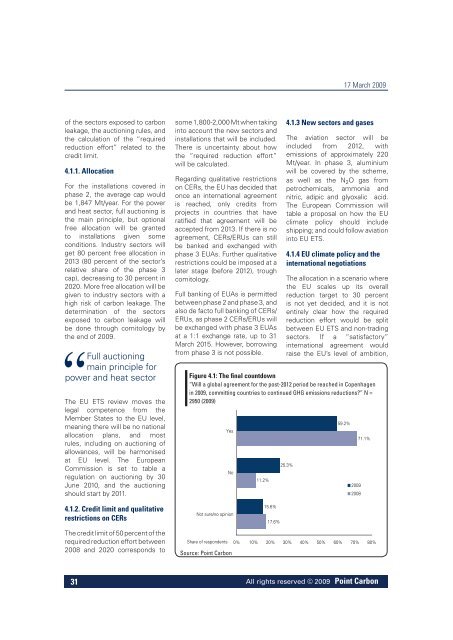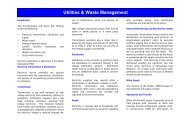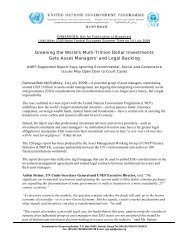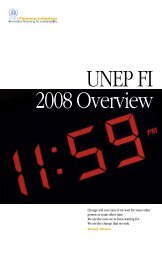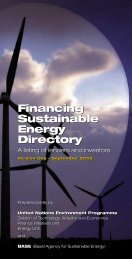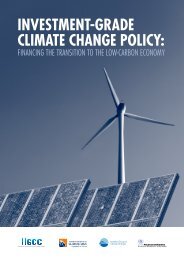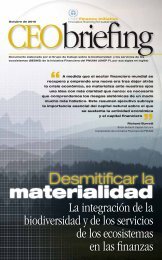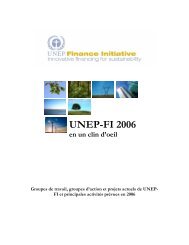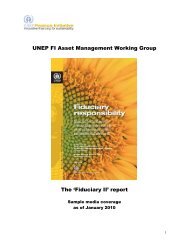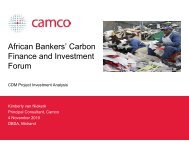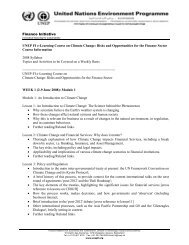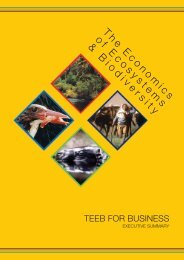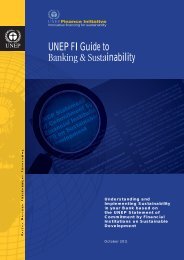Carbon 2009 Emission trading coming home - UNEP Finance Initiative
Carbon 2009 Emission trading coming home - UNEP Finance Initiative
Carbon 2009 Emission trading coming home - UNEP Finance Initiative
You also want an ePaper? Increase the reach of your titles
YUMPU automatically turns print PDFs into web optimized ePapers that Google loves.
17 March <strong>2009</strong><br />
of the sectors exposed to carbon<br />
leakage, the auctioning rules, and<br />
the calculation of the “required<br />
reduction effort” related to the<br />
credit limit.<br />
4.1.1. Allocation<br />
For the installations covered in<br />
phase 2, the average cap would<br />
be 1,847 Mt/year. For the power<br />
and heat sector, full auctioning is<br />
the main principle, but optional<br />
free allocation will be granted<br />
to installations given some<br />
conditions. Industry sectors will<br />
get 80 percent free allocation in<br />
2013 (80 percent of the sector’s<br />
relative share of the phase 3<br />
cap), decreasing to 30 percent in<br />
2020. More free allocation will be<br />
given to industry sectors with a<br />
high risk of carbon leakage. The<br />
determination of the sectors<br />
exposed to carbon leakage will<br />
be done through comitology by<br />
the end of <strong>2009</strong>.<br />
Full auctioning<br />
main principle for<br />
power and heat sector<br />
The EU ETS review moves the<br />
legal competence from the<br />
Member States to the EU level,<br />
meaning there will be no national<br />
allocation plans, and most<br />
rules, including on auctioning of<br />
allowances, will be harmonised<br />
at EU level. The European<br />
Commission is set to table a<br />
regulation on auctioning by 30<br />
June 2010, and the auctioning<br />
should start by 2011.<br />
4.1.2. Credit limit and qualitative<br />
restrictions on CERs<br />
The credit limit of 50 percent of the<br />
required reduction effort between<br />
2008 and 2020 corresponds to<br />
some 1,800-2,000 Mt when taking<br />
into account the new sectors and<br />
installations that will be included.<br />
There is uncertainty about how<br />
the “required reduction effort”<br />
will be calculated.<br />
Regarding qualitative restrictions<br />
on CERs, the EU has decided that<br />
once an international agreement<br />
is reached, only credits from<br />
projects in countries that have<br />
ratified that agreement will be<br />
accepted from 2013. If there is no<br />
agreement, CERs/ERUs can still<br />
be banked and exchanged with<br />
phase 3 EUAs. Further qualitative<br />
restrictions could be imposed at a<br />
later stage (before 2012), trough<br />
comitology.<br />
Full banking of EUAs is permitted<br />
between phase 2 and phase 3, and<br />
also de facto full banking of CERs/<br />
ERUs, as phase 2 CERs/ERUs will<br />
be exchanged with phase 3 EUAs<br />
at a 1:1 exchange rate, up to 31<br />
March 2015. However, borrowing<br />
from phase 3 is not possible.<br />
4.1.3 New sectors and gases<br />
The aviation sector will be<br />
included from 2012, with<br />
emissions of approximately 220<br />
Mt/year. In phase 3, aluminium<br />
will be covered by the scheme,<br />
as well as the N 2 O gas from<br />
petrochemicals, ammonia and<br />
nitric, adipic and glyoxalic acid.<br />
The European Commission will<br />
table a proposal on how the EU<br />
climate policy should include<br />
shipping; and could follow aviation<br />
into EU ETS.<br />
4.1.4 EU climate policy and the<br />
international negotiations<br />
The allocation in a scenario where<br />
the EU scales up its overall<br />
reduction target to 30 percent<br />
is not yet decided, and it is not<br />
entirely clear how the required<br />
reduction effort would be split<br />
between EU ETS and non-<strong>trading</strong><br />
sectors. If a “satisfactory”<br />
international agreement would<br />
raise the EU’s level of ambition,<br />
Figure 4.1: The final countdown<br />
“Will a global agreement for the post-2012 period be reached in Copenhagen<br />
in <strong>2009</strong>, committing countries to continued GHG emissions reductions?” N =<br />
2950 (<strong>2009</strong>)<br />
Not sure/no opinion<br />
Share of respondents<br />
Yes<br />
No<br />
Source: Point <strong>Carbon</strong><br />
11.2%<br />
15.6%<br />
17.6%<br />
25.3%<br />
59.2%<br />
<strong>2009</strong><br />
2008<br />
71.1%<br />
0% 10% 20% 30% 40% 50% 60% 70% 80%<br />
31<br />
All rights reserved © <strong>2009</strong> Point <strong>Carbon</strong>


